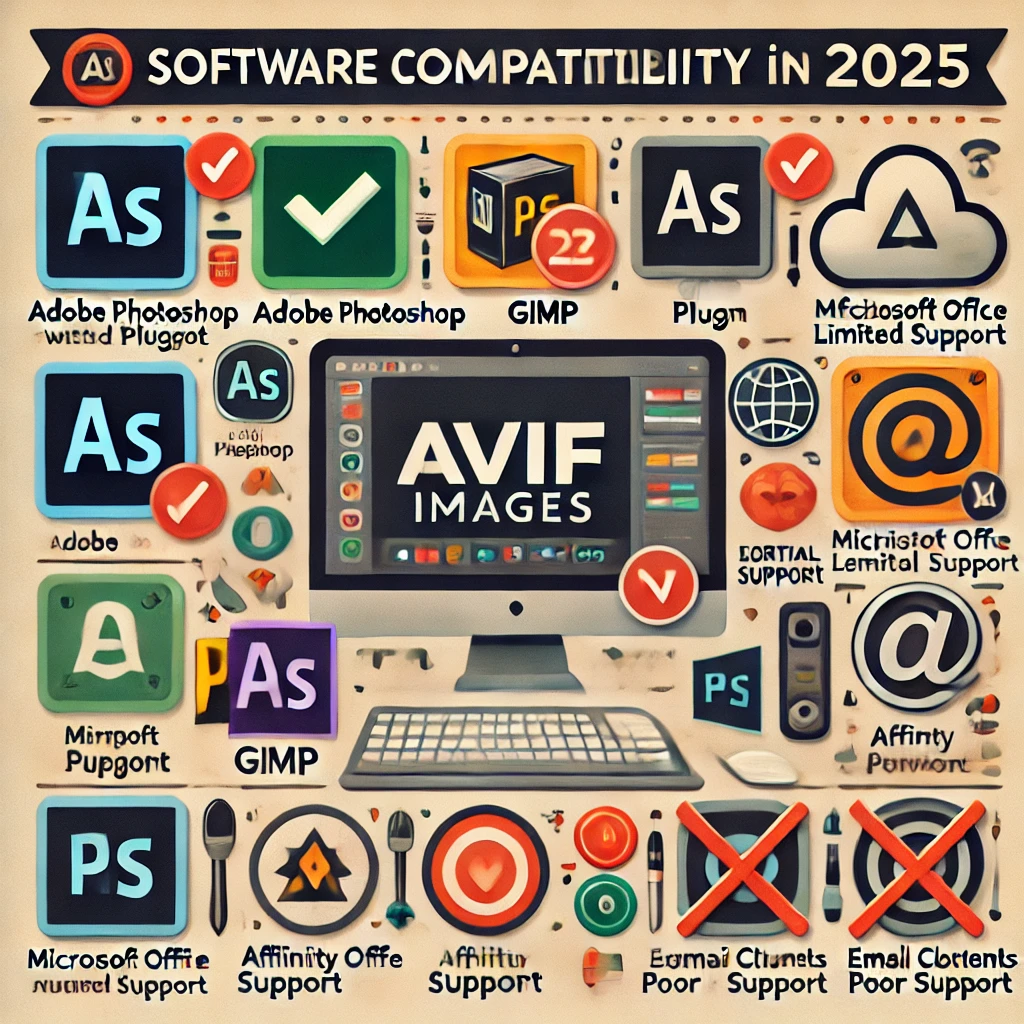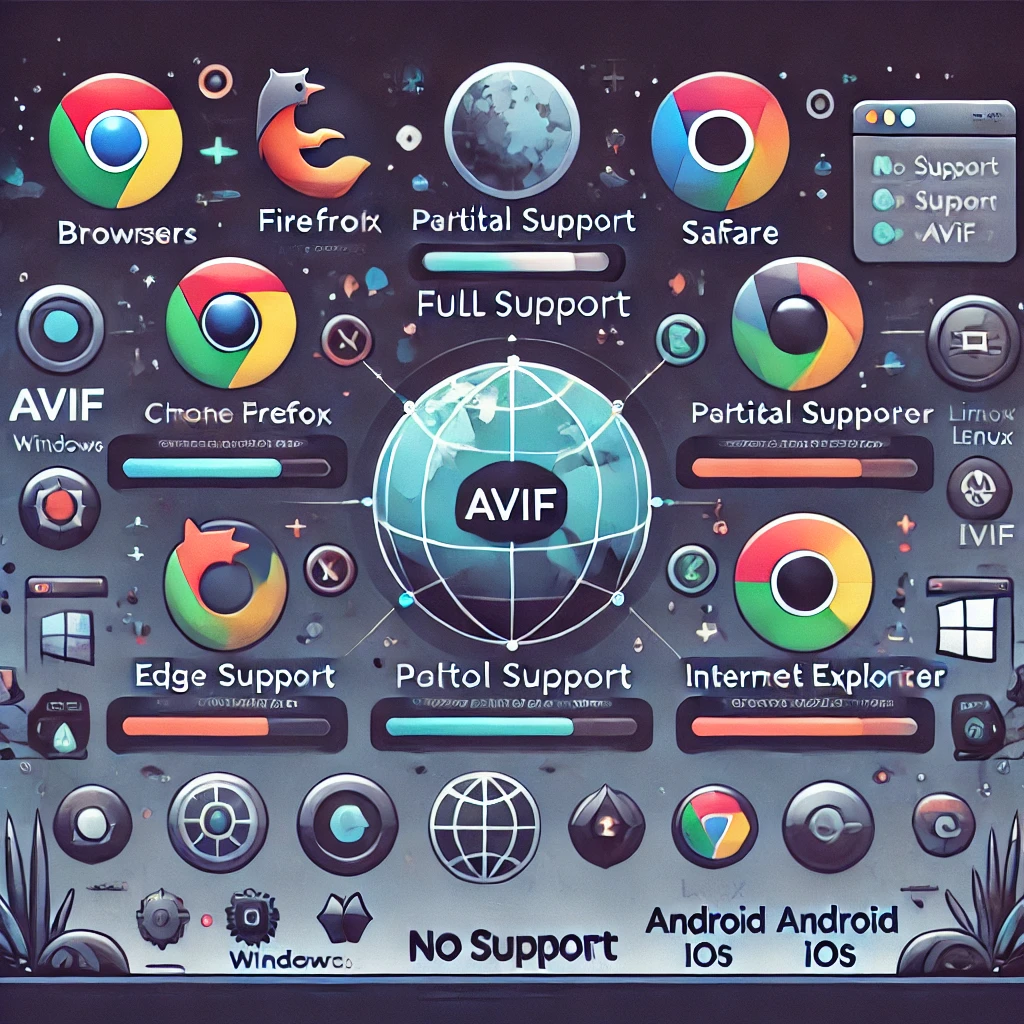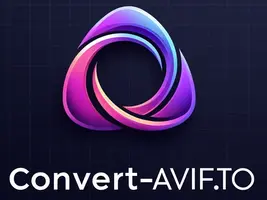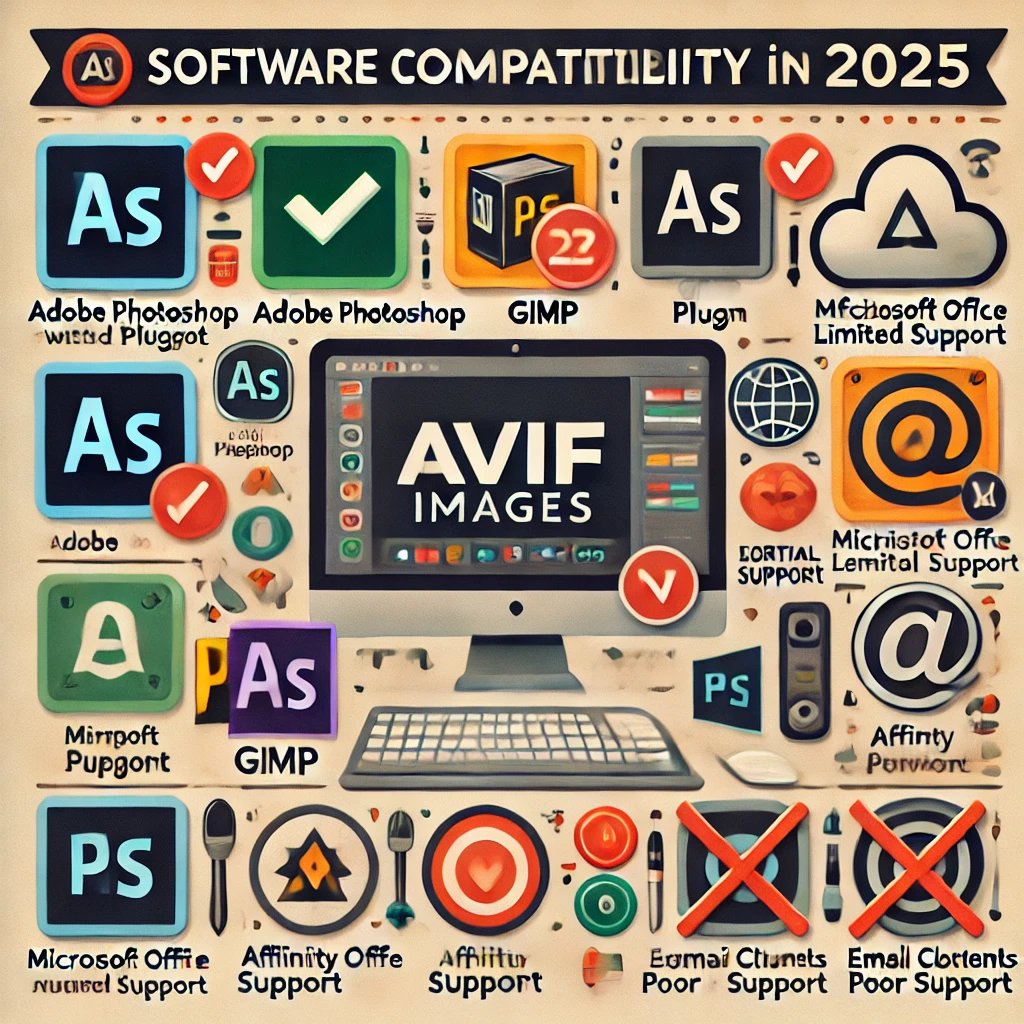Common AVIF Compatibility Issues Explained
While AVIF offers remarkable compression efficiency and image quality, users often encounter compatibility challenges when working with this next-generation format. As AVIF adoption grows, understanding these compatibility issues and their solutions becomes increasingly important for developers, content creators, and everyday users. This comprehensive guide explores the most common AVIF compatibility challenges and provides practical solutions to ensure your images work seamlessly across platforms.
Current Compatibility Landscape
AVIF has made tremendous strides in adoption since its introduction in 2019, but compatibility remains a work in progress across the digital ecosystem.
Browser Support Status

As of April 2025, browser support for AVIF has reached critical mass but isn’t yet universal:
-
Chrome: Fully supported since version 85 (August 2020)
-
Firefox: Fully supported since version 93 (October 2021)
-
Safari: Supported since version 16.4 (March 2023)
-
Edge: Supported (based on Chromium)
-
Opera, Brave, Vivaldi: Supported (based on Chromium)
-
Samsung Internet: Supported since version 16.0
-
Internet Explorer: No support (discontinued)
-
Older browser versions: No support
While this covers approximately 97% of current web users, a small but significant portion of users on older or specialized browsers cannot natively display AVIF images.
Operating System Integration
Operating system support varies significantly:
-
Windows: Native support in Windows 10 (with updates) and Windows 11
-
macOS: Support in macOS Big Sur (11.0) and later
-
iOS: Support in iOS 16.4 and later
-
Android: Support in Android 12 and later
-
Linux: Support varies by distribution and installed packages
This fragmented support creates challenges when sharing AVIF files outside of web contexts, as users on older operating systems may be unable to view the images without additional software.
Software Application Support
Application support remains inconsistent:
-
Adobe Photoshop: Support added in 2022 updates
-
GIMP: Support via plugins
-
Affinity Photo: Limited support
-
Microsoft Office: Partial support in newer versions
-
Social media platforms: Variable support (some convert to JPEG behind the scenes)
-
Email clients: Generally poor support
This uneven application support creates friction points when AVIF images need to move through different software in a workflow.
Common Compatibility Issues and Solutions
Let’s explore the most frequently encountered compatibility problems and their practical solutions.
Issue 1: Unsupported Browsers
Problem: A significant minority of users may be using browsers that don’t support AVIF, resulting in broken images.
Solutions:
-
Implement proper fallbacks: Use the HTML
<picture>Element to provide alternative formats:
<picture>
<source srcset="image.avif" type="image/avif">
<source srcset="image.webp" type="image/webp">
<img src="image.jpg" alt="Description">
</picture>
-
Server-side content negotiation: Detect browser capabilities through the Accept header and serve appropriate image formats:
# Apache configuration example
<IfModule mod_rewrite.c>
RewriteEngine On
RewriteCond %{HTTP_ACCEPT} image/avif
RewriteCond %{REQUEST_FILENAME} -f
RewriteRule (.+)\.(jpe?g|png)$ $1.avif [T=image/avif,L]
</IfModule>
-
Progressive enhancement: Start with universally supported formats and enhance the experience for browsers with AVIF support.
Issue 2: Operating System Limitations
Problem: Users may be unable to view AVIF files in their operating system’s native image viewer.
Solutions:
-
Provide alternative downloads: Offer both AVIF and JPEG/PNG versions for download.
-
Recommend compatible viewers: Suggest free, cross-platform viewers that support AVIF:
-
XnView MP
-
ImageMagick
-
IrfanView (with plugins)
-
-
Use online converters: Direct users to services like convert-avif to convert AVIF files to more compatible formats when needed.
Issue 3: Software Compatibility Gaps
Problem: Professional software and applications may not support AVIF, breaking workflows.
Solutions:
-
Conversion workflows: Establish conversion points in workflows where AVIF files are converted to compatible formats before entering unsupported software.
-
Plugin solutions: Install AVIF plugins for popular software where available:
-
GIMP AVIF plugin
-
Photoshop WebP & AVIF plugin (for older versions)
-
-
Command-line tools: Use tools like
libavifFor batch conversion in automated workflows:
# Example of batch conversion using avifenc
for file in *.png; do
avifenc -a end-usage=q -a cq-level=30 "$file" "${file%.png}.avif"
done
Issue 4: Email and Messaging Limitations
Problem: AVIF images often don’t display in email clients or messaging apps.
Solutions:
-
Convert before sharing: Always convert AVIF to JPEG or PNG before attaching to emails or messages.
-
Web links instead of attachments: Host AVIF images on the web with proper fallbacks and share links instead of attachments.
-
Automated conversion: Set up tools that automatically convert AVIF to JPEG when sending through incompatible channels.
Issue 5: Social Media Platform Issues
Problem: Many social media platforms don’t accept AVIF uploads or strip AVIF images of their advantages by converting them to JPEG.
Solutions:
-
Platform-specific formats: Convert AVIF to the optimal format for each platform before uploading.
-
Test before bulk uploading: Test single images on each platform to verify handling before uploading entire collections.
-
Host externally: For maximum quality, host AVIF images on your own site and share links instead of uploading directly to social platforms.
Technical Compatibility Challenges
Beyond basic support issues, several technical compatibility challenges can affect AVIF implementation.
AVIF Profile and Level Compatibility
AVIF defines different profiles (Baseline and Advanced) and levels that specify constraints on features like dimensions and bit depth. Not all decoders support all profiles and levels, which can lead to compatibility issues even on platforms that generally support AVIF.
Solution: Encode AVIF files using the Baseline profile and conservative level settings for maximum compatibility:
# Example of encoding with baseline profile for maximum compatibility
avifenc --min 0 --max 63 --speed 6 --yuv 420 --depth 8 input.png output.avif
HDR Content Compatibility
AVIF supports HDR imaging, but many systems’ display pipelines don’t correctly handle HDR content, resulting in washed-out or incorrect colors.
Solution: For content that needs to be widely compatible, convert HDR AVIF images to SDR versions, or provide both versions with appropriate detection:
<picture>
<source srcset="image-hdr.avif" type="image/avif" media="(color-gamut: p3)">
<source srcset="image-sdr.avif" type="image/avif">
<img src="image.jpg" alt="Description">
</picture>
Animation Support Variations
While AVIF supports animation, implementation varies across browsers and applications, leading to inconsistent playback.
Solution: For critical animated content, continue using more widely supported formats like animated WebP or MP4 video, while offering AVIF animations as progressive enhancements.

Compatibility Testing Strategies
Ensuring AVIF compatibility across your target platforms requires systematic testing.
Browser Testing Matrix
Create a testing matrix covering:
-
Major browsers (Chrome, Firefox, Safari, Edge)
-
Multiple versions of each browser
-
Mobile and desktop variants
-
Different operating systems
Use browser developer tools to simulate older versions and different devices.
Feature Detection
Implement robust feature detection rather than browser sniffing:
function avifSupported() {
const canvas = document.createElement('canvas');
return canvas.toDataURL('image/avif').indexOf('data:image/avif') === 0;
}
if (avifSupported()) {
// Use AVIF
} else {
// Use fallback format
}
Automated Testing Tools
Leverage tools that can verify image rendering across platforms:
-
Browser automation tools like Playwright or Puppeteer
-
Visual regression testing services
-
Cross-browser testing platforms like BrowserStack or LambdaTest
Future-Proofing Your AVIF Implementation
As AVIF support continues to evolve, several strategies can help future-proof your implementation.
Responsive Image Best Practices
Implement responsive images using both format and resolution switching:
<picture>
<source
type="image/avif"
srcset="image-large.avif 1200w, image-medium.avif 800w, image-small.avif 400w"
sizes="(max-width: 600px) 100vw, (max-width: 1200px) 50vw, 33vw">
<source
type="image/webp"
srcset="image-large.webp 1200w, image-medium.webp 800w, image-small.webp 400w"
sizes="(max-width: 600px) 100vw, (max-width: 1200px) 50vw, 33vw">
<img
src="image-fallback.jpg"
srcset="image-large.jpg 1200w, image-medium.jpg 800w, image-small.jpg 400w"
sizes="(max-width: 600px) 100vw, (max-width: 1200px) 50vw, 33vw"
alt="Description">
</picture>
Content Delivery Networks (CDNs)
Utilize CDNs that offer automatic format conversion and content negotiation:
-
Cloudinary
-
Fastly
-
Akamai Image and Video Manager
-
imgix
These services can automatically serve the optimal format based on the requesting browser.
Regular Compatibility Audits
Schedule regular compatibility audits to:
-
Test AVIF support in newly released browsers and operating systems
-
Update fallback strategies as needed
-
Adjust encoding parameters based on evolving decoder capabilities
Conclusion
While AVIF offers compelling advantages regarding compression efficiency and image quality, navigating its compatibility landscape requires thoughtful implementation strategies. By understanding the current state of AVIF support and implementing robust fallback mechanisms, you can leverage AVIF’s benefits while ensuring a seamless user experience.
As browser and application support continues to improve, many of these compatibility issues will gradually disappear. Until then, a pragmatic approach that combines AVIF’s advantages with reliable fallbacks will deliver the best results across the digital ecosystem.
Do you need to convert AVIF files for compatibility reasons? Visit convert-avif.to for fast, free, and high-quality conversions between AVIF and widely supported formats like JPG, PNG, and PDF.

